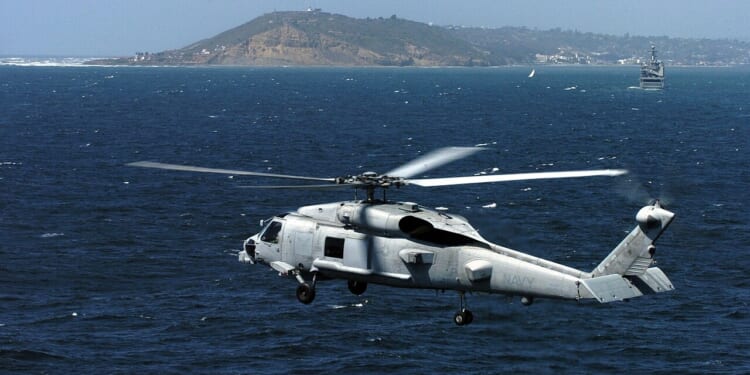Although the US Navy is planning to bring drones online to aid in many of the Seahawk’s functions, the rugged helicopter will endure in the service for years to come.
For more than 40 years, the US Navy has relied upon the Sikorsky MH-60 Seahawk, a multi-functional helicopter system adapted for anti-submarine warfare, surface strikes, search and rescue, logistics, and electronic surveillance. In essence, the MH-60 does it all—serving as the backbone of America’s seapower.
The MH-60 Helicopter’s Specifications
- Year Introduced: 1984 (SH-60B); current MH-60R/S variants entered service in early 2000s
- Number Built: ~700+ across all naval variants (SH-60B/F, MH-60R, MH-60S; still in production)
- Length: 64.8 ft (19.76 m) overall
- Rotor Diameter: 53.8 ft (16.4 m) main rotor
- Weight: ~23,500 lb (10,660 kg) maximum takeoff weight, depending on variant
- Engines: Two General Electric T700-GE-401C turboshafts (~1,900 shp each)
- Top Speed: ~168 knots (193 mph, 311 km/h)
- Range: ~245 nmi (282 mi, 454 km) combat radius; ~450+ nmi ferry range with auxiliary tanks; 3.5 hours’ endurance on standard fuel load
- Service Ceiling: ~12,000 ft (3,660 m)
- Loadout: Common Cockpit digital glass cockpit (Rockwell Collins/Lockheed Martin); integrated mission computers, Link-16 datalink, radar warning receivers, GPS/INS navigation, and night vision goggle compatibility
- MH-60R (Romeo): 2× Mk 46 or Mk 54 lightweight torpedoes, up to 4× AGM-114 Hellfire missiles, machine guns (GAU-21 .50 cal or M240D 7.62mm); AN/AQS-22 dipping sonar; AN/APS-153(V) radar; FLIR turret; sonobuoy launchers.
- MH-60S (Sierra): Door guns, rescue hoist, 9,000 lb (4,080 kg) cargo hook; can carry Hellfires, GAU-21s, or 70mm rockets with Armed Helo kit; supports troop or medevac transport for up to 8–10 personnel.
- Aircrew: Typically 3 (pilot, copilot, and sensor operator/crew chief)
The MH-60 Was Built for the Sea
The MH-60 is derived from the US Army’s UH-60 Black Hawk, and accordingly, has been modified to survive the hardships of life at sea. From the keel up, the MH-60 has been redesigned to survive against the onslaught of salt and turbulence that characterizes Navy life. Every hinge, bearing, and fastener is coated or sealed against corrosion. The landing gear is reinforced for impact aboard a ship. Folding rotor blades and a folding tail boom allow the MH-60 to collapse into the tight confines of a destroyer’s hangar bay, something the UH-60 progenitor could not accomplish. The MH-60 airframe is primarily aluminum-lithium alloy, with extensive use of titanium in the tail pylon and gearbox mounts—making for a light, strong, and sea-resistant craft.
Beneath the skin of the MH-60 lies a formidable suite of systems. It carries the AN/AQS-22 Airborne Low-Frequency Sonar, a digital dipping sonar capable of detecting diesel-electric submarines lurking hundreds of feet below the surface. Complementing the sonar are sonobuoy launchers, magnetic anomaly detectors, and datalinks that feed real-time acoustic data to the ship’s combat system.
The MH-60 is even adapted to provide firepower. In a surface warfare configuration, the helicopter mounts twin AGM-114 Hellfire missiles on external pylons and can sling Mk 46 or Mk 54 torpedoes from its internal weapons bay. The electro-optical turret—an advanced FLIR—allows the crew to track small boats or periscopes in near darkness.
The MH-60 Has Strategic Implications for the Navy
Strategically, the MH-60 adds value through enhancing a fleet’s lethality. For the Navy, operating in dispersed environments across thousands of square miles of ocean, each surface vessel must operate as a semi-independent combat cell. Accordingly, a destroyer with an embarked MH-60 can search for submarines across hundreds of square miles, prosecute contacts without revealing the ship’s position, and share targeting data with aircraft and submarines alike. In effect, the MH-60 extends the fleet’s reach.
Naturally, the future is likely to bring some sort of manned-unmanned integration for the MH-60. The Navy is already pairing the MH-60 with unmanned MQ-8C Fire Scout helicopters for extended reconnaissance missions. Regardless, the MH-60 is likely to remain relevant through the 2040s, thanks to various upgrades. A next-generation replacement is already being considered under the Future Vertical Lift program. But that replacement will be online in the near-term future; for now, the MH-60 will remain indispensable to naval operations.
About the Author: Harrison Kass
Harrison Kass is a senior defense and national security writer at The National Interest. Kass is an attorney and former political candidate who joined the US Air Force as a pilot trainee before being medically discharged. He focuses on military strategy, aerospace, and global security affairs. He holds a JD from the University of Oregon and a master’s in Global Journalism and International Relations from NYU.
Image: Wikimedia Commons.


















